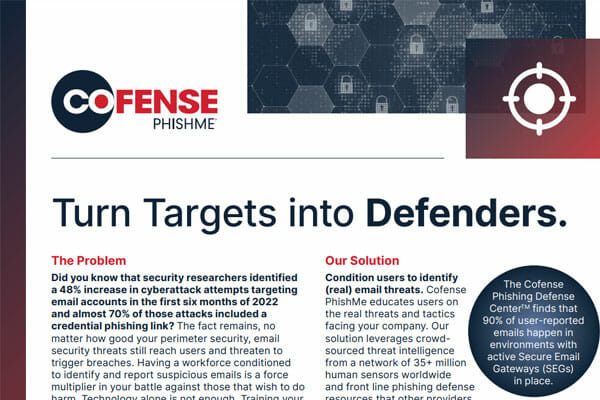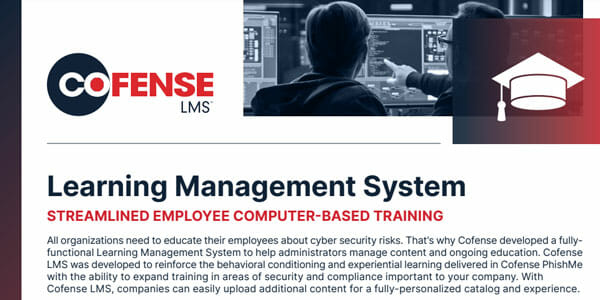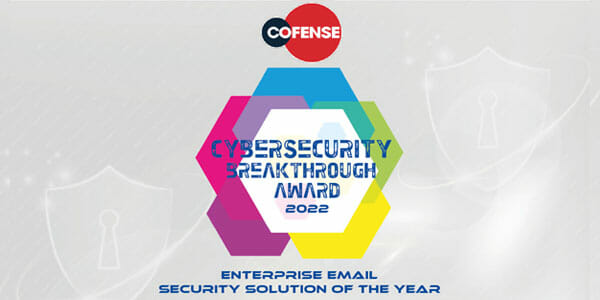The Benefits of Security Awareness Training with Cofense
Condition your workforce against today’s latest threats and transform them into your front line of defense.
Educate Your Employees on Real Cyber Threats
Do you want your users to learn how to recognize and report real threats facing organizations today? Good, so do we.
Our content focuses on real security threats and phishing emails, identified by Cofense Intelligence, that are bypassing Secure Email Gateways (SEGs).
Available in a variety of formats such as live action games, micro-learning and more, our world-class content focuses on phishing, ransomware, Business Email Compromise (BEC), malware, social networking and more to help train your users to spot and stop the latest email attacks.
Threat Fidelity
We focus on real threats. We don’t make them up. Educate your users in multiple formats on real-world phishing examples bypassing Secure Email Gateways (SEGs) thanks to insights from our intelligence team.
Engagement
We take real threats and create engaging ways for your users to learn. From interactive simulations to adaptive game-based learning, our content is created with the sole purpose of the end user.
Global
We work with companies and countries around the world. With localized content available in up to 32 languages, it’s our goal to provide you with the most realistic scenarios available.
What Our Customers Say
Our Security Awareness Training content is the educational manifestation of our cyber-threat mastery. Our training content rests on three pillars of value: accurate alignment to the threat landscape, cutting-edge tactics, and high learner engagement.
That’s why we educate users on real phishing tactics your company faces. We leverage extensive research, threat intelligence, and front-line phishing defense resources that other providers lack.
Through experiential learning—simulations of current phishing threats—you’ll condition smarter email behavior, transforming vulnerable targets into an essential layer of defense.
Security Awareness Training FAQs
Security awareness training is an important aspect of modern cyber security. It’s a comprehensive way to train employees on how to safely navigate the digital world by identifying, understanding and mitigating risks posed by malicious actors.
At its core, security awareness training is designed to educate users on current threats in their working environment, inform them of the common tactics that attackers use (including phishing attempts), and equip them with best practices for avoiding online dangers. When done correctly, it should empower personnel with an understanding of how they can protect themselves and their company from potential attack vectors.
Phishing awareness is more than being aware of what a phishing email may look like. Employees need to understand the different types of phishing, how attacks can be engineered, and the consequences of clicking on a malicious link, responding to an email with the requested information or opening a file.
Phishing training for employees is one of the most effective ways to strengthen your company´s defenses against malware, ransomware, data loss, and Business Email Compromise (BEC) attacks.
Moreover, when your users report threats, your company can receive reciprocal information about phishing attacks found elsewhere. Such information can be delivered in Machine-Readable Threat Intelligence (MRTI) format, so it can be fed directly into existing security mechanisms (i.e. malicious URL detection systems), which update your technically driven online defenses against malware, data loss, and ransomware attacks.
One of the best ways to raise security awareness is to send simulated phishing emails to employees and stage attacks. Spear phishing and BEC attacks can be highly refined and personal. To make simulation training more impactful, include spear phishing awareness training by crafting messages that are addressed to an individual or specific group. Employ the personal and professional information you have on file to better simulate real phishing attacks that utilize social engineering. Sending a phishing email simulation containing a fake invoice query is simpler but may lack the relevant content that will make it an effective educational tool for every department.
The goals of phishing email simulation should be to build employee confidence, encourage communication, and establish habits that mitigate phishing attacks. Successfully using simulations is just one part of a larger phishing awareness campaign.
A security awareness campaign is an organized effort by a company or enterprise to help employees and other personnel understand the basics of information security and related policies.
It can consist of several different elements such as communication strategies, policies, training programs and activities.
The main purpose of a security awareness campaign is to promote secure behavior among all members of an organization, protecting sensitive data from malicious threats.
A security awareness training program can be part of on-boarding, regular training, or done randomly to test the phishing security awareness of individuals or groups. The most effective programs will be thorough and ongoing.
Your security training should feature feedback, monitoring, and reporting.
Feedback should go something like this: “Here’s what you did right and here’s what you did wrong,” noting the reasons why. This lets employees and senior management discover both their weaknesses and the areas they need to improve upon.
Using LMS training allows you to do this at scale.


